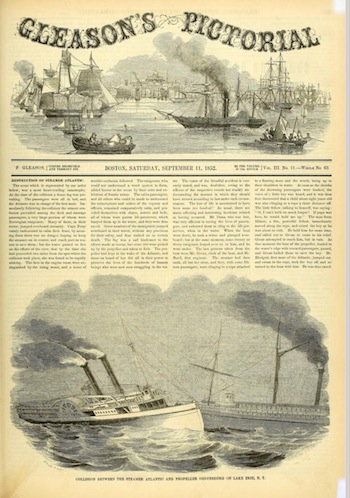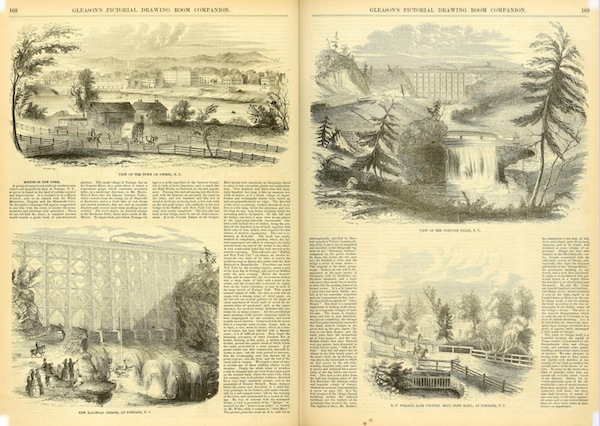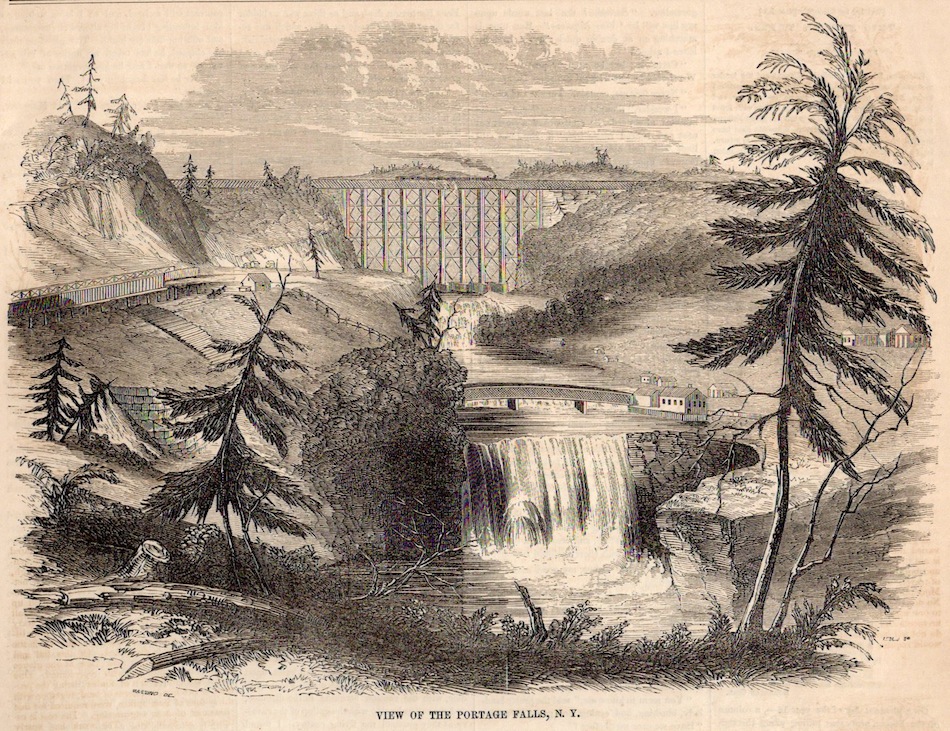Gleason Pictorial Drawing-Room Companion September 11, 1852
“Scenes in New York”
“A group of natural and artificial wonders more varied and magnificent that at Portage, N.Y., is not to be found in this land of sublime scenery and improvement. It is destined to be a Mecca of travel, only to be classed with the White Mountains, Niagara and the Mammoth Cave. No descriptive language will appear exaggerated to one who visits the scenery, or studies the measurements and drawings now presented. These do not tell half the story; a complete account would require a guide book of pen-and-pencil sketches.
The small village of Portage (1) lies on the Genesee River, at a point where it enters a stupendous gorge, which continues seventeen miles, in a north-east direction, to Mt. Morris. Here it flows into the famous Genesee Valley, which extends from the young city of Dansville (2) to Rochester, and is a level lake of rich farms and shaded meadows, that are said to resemble English park scenery more that anything in our country.
The river makes its farewell oration at the Rochester Falls, thirty miles north of Mt. Morris. To begin back, just below Portage village is a noble aqueduct of the Genesee Canal (3); this is built of hewn limestone, and is much like the High Bridge at Harlaem (sic), in size and appearance. Passing this and advancing into the river gulf, with the Genesee on one hand, the canal on the other, and two hundred and fifty feet of wooded declivity enclosing both, a few rods walk on the tow-path brings you suddenly to the new bridge of the Buffalo and New York City Railroad, now nearly completed. The first and last look at this bridge must be one of dumb amazement. It is the Crystal Palace of all bridges.
How mortal every conceived, or, designing, dared to carry it into execution, passes our comprehension. Two hundred and thirty-four feet high, eight hundred feet long, it lifts an immense network of timber, as if a whole village of house frames and rectangular streets were raised up and set perpendicularly on edge, The first fall of the river, a sidelong, broken descent of sixty feet, is a few steps below the structure, and visible from its top, long before reaching which the ascending mist is dissipated. Of this fall and the bridge, you have a near view at one glance in the engravings herewith represented.
One and a half million feet of timber, being the product of two hundred acres of land, together with thirty tons of iron spikes, were required for this climax of modern engineering. The cost is estimated at $130,000. The work has nearly reached its completion, pending which, the railroad passengers are taken in carriages two miles around from one end of the bridge to the other.(4)
A very comfortable hotel has been erected at the eastern extremity. (5) This railroad - the “Buffalo and New York City” - is almost an air-line between the two cities of its title; it leaves the northern road at Attica and unites with the Erie Railroad at Hornellsville. (6) Travelers can leave New York by the evening express, spend a part of the next day at Portage, and arrive at Buffalo early the next evening.
Below the monster bridge and its water-fall, the river-chasm widens into a deep basin of hills, with a pond in the centre, and the second fall - a descent of eighty feet - at the lower extremity, as may be seen in the large sketch of Portage Fall. (7) This grand natural temple of cliffs, has thus at each end an organ with a shining range of silver pipes; on the left side are several galleries in the shape of canal aqueducts of wood, built to avoid the incessant slides of quicksand; and, at the upper entrance, the six story bridge furnishes fifty rostrums for as many orators. All the presidential mass meetings of the present campaign might be her congregated on one occasion, and much trouble saved thereby. (8)
Connected with the lower falls is a singular semi-circular chasm, and at its base, a cave worn by water which, as matter of course, has been afflicted with a Satanic name; it is of difficult access. (9) Here begin the imposing precipices of three hundred feet in height, forming, at this point, a mighty amphi-theatre, around the eastern brink of which winds the canal, protected by a stone parapet. A gigantic tunnel was first constructed, and still remains in part; but the rock proved so insecure , that the overhanging roof was thrown off, at great expense, into the river, and the bed of the canal laid in cement. We regret a want of time to include any of these striking objects in our sketches.(10)
Nearly the whole array of wonders could be brought into one view from a high point on the western bank, where the artist Cole, when this scenery was in its pristine wildness, sketched for a very large autumnal picture, now in the possession of Senator Seward. (11) Some distance below the places now described, is a third fall, very grotesque in its features, and made remarkable by a tall natural tower, left by the wearing of the river and surmounted by a crown of foliage.”
Footnotes
(1) The writer is referring to Portageville.
(2) Dansville is at the head of the Canaseraga Valley. The Canaseraga Creek joins the Genesee River just east of Mt. Morris, outside the present day Park.
(3) This is the Genesee Valley Canal which had just opened in this section.
(4) The bridge was completed in the summer of 1852, so it is likely that the author visited the area in the late spring of that year.
(5) This would be the famous Cascade House.
(6) The Buffalo and New York City Railroad later became part of the Erie Railroad.
(7) The “pond” mentioned is the river flowing between the Upper and Middle Falls. At the time there was a mill dam above the Middle Falls which turned that section into a pond of sorts.
(8) The presidential campaign of that year was between the Democrat Franklin Pierce and the Whig, Winfield Scott. At the time of the writing the President was Millard Fillmore of Buffalo, who was a friend of William Pryor Letchworth.
(9) The writer is actually discussing the Middle Falls here. The cave called “Devil’s Oven” can still be seen today.
(10) The remnant of the failed tunnel is known today as the “Bat Cave”. His description of the canal’s construction process after the tunnel was abandoned is misleading. A ledge was created on the cliff face, and the canal was dug along the ledge. It was not “laid in cement” as we call it today - it was dug out and then lined with a “puddling” to hold the water.
(11) The famous landscape artist Thomas Cole had come to the Portage Falls twenty years before. His famous painting of the Middle Falls and Hornby Lodge hung for many years in the Seward Mansion in Auburn. Visit our page on this famous artist.



